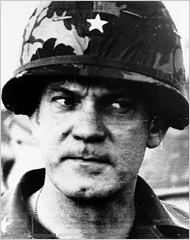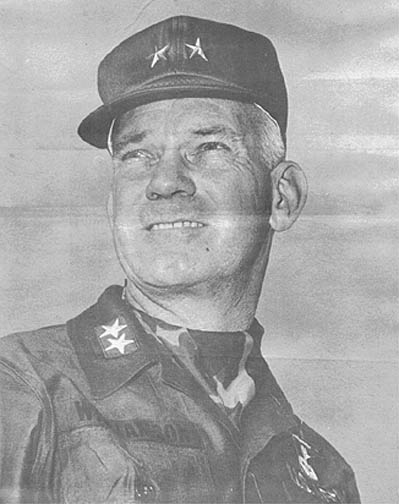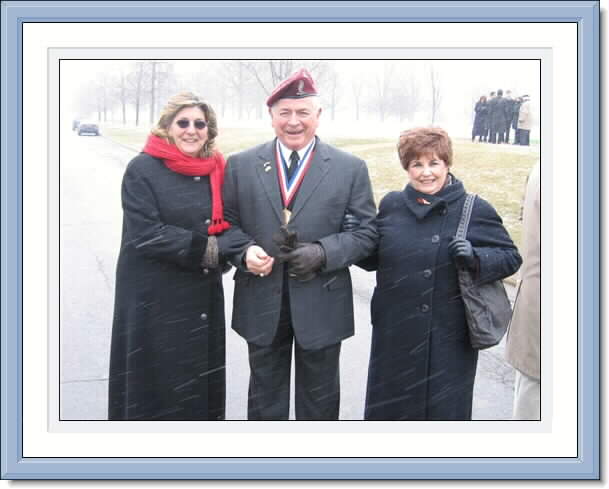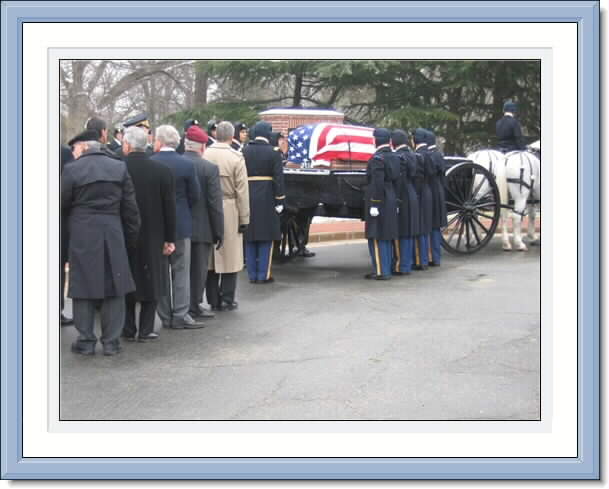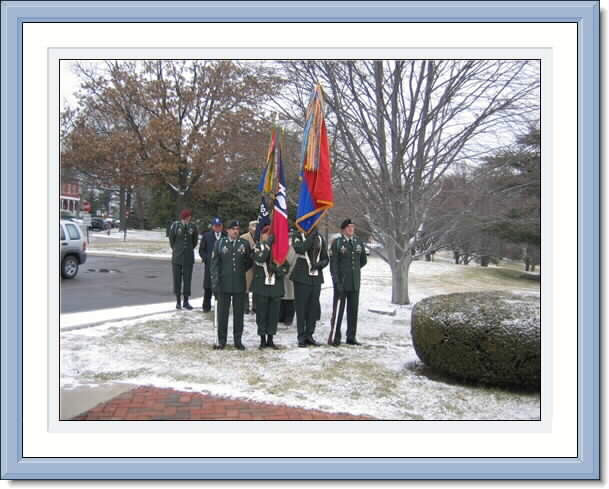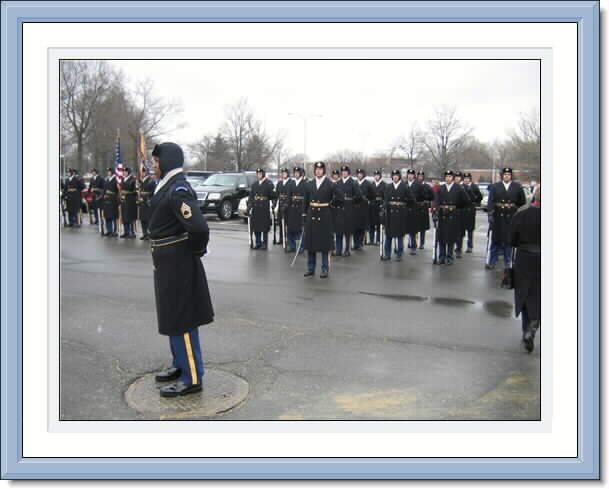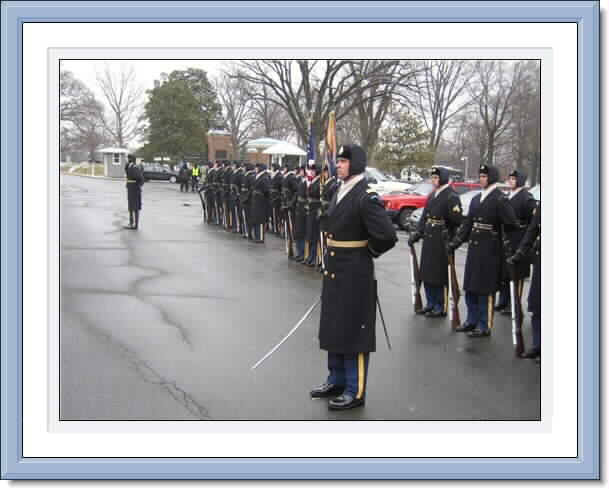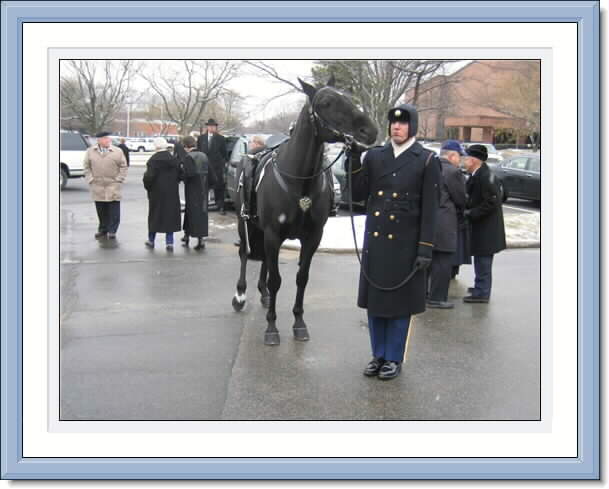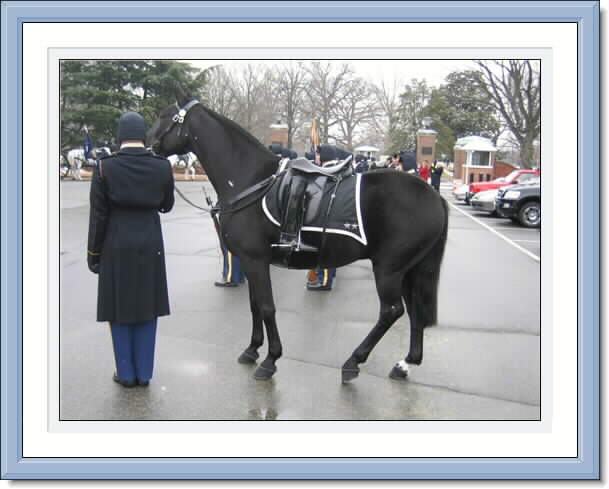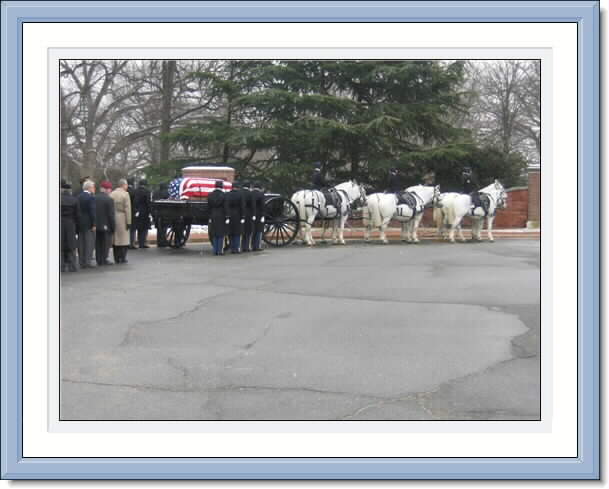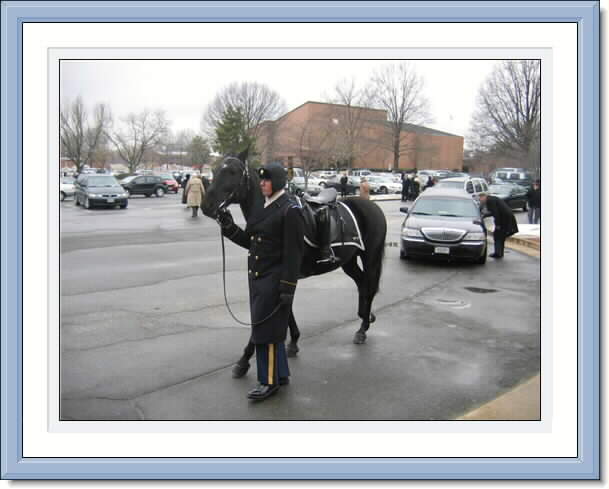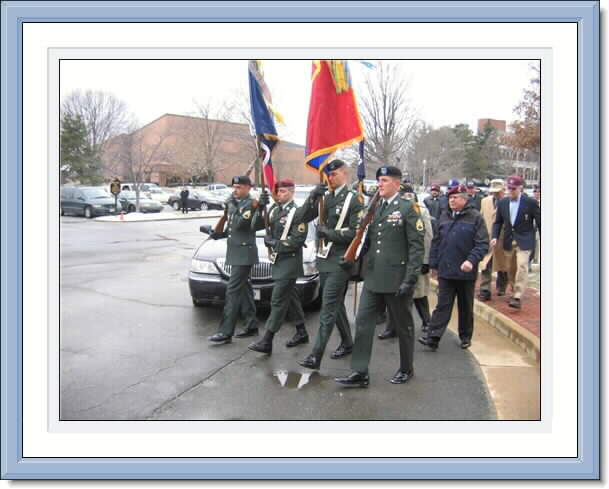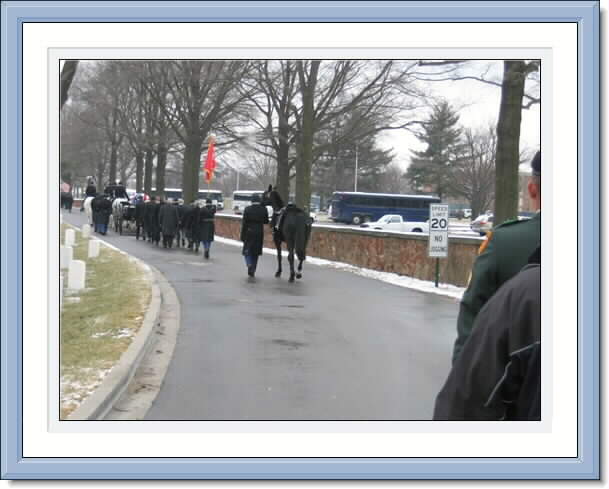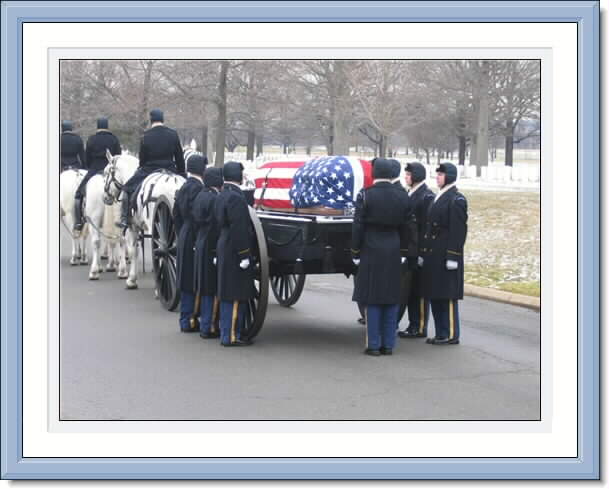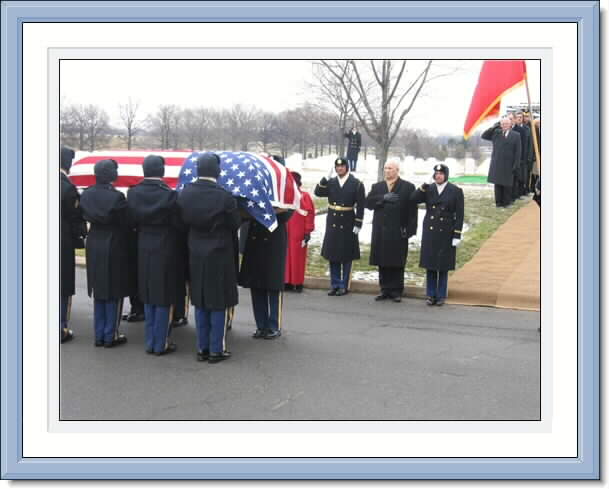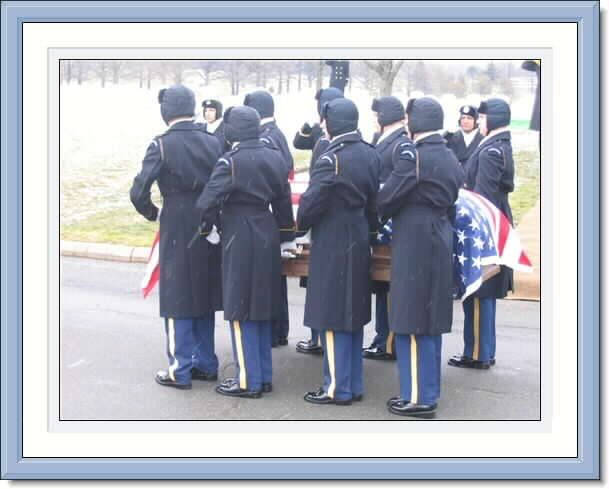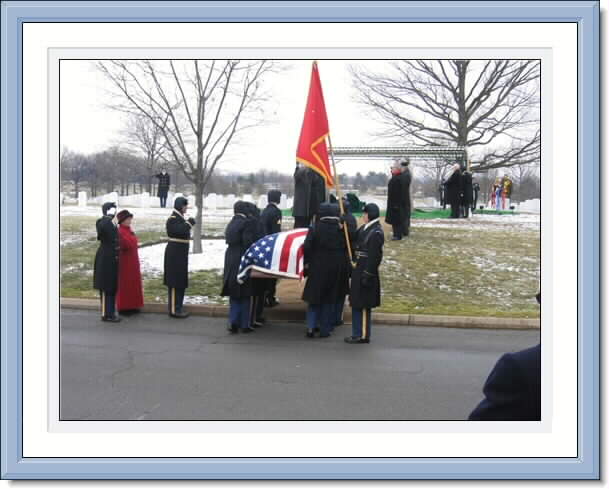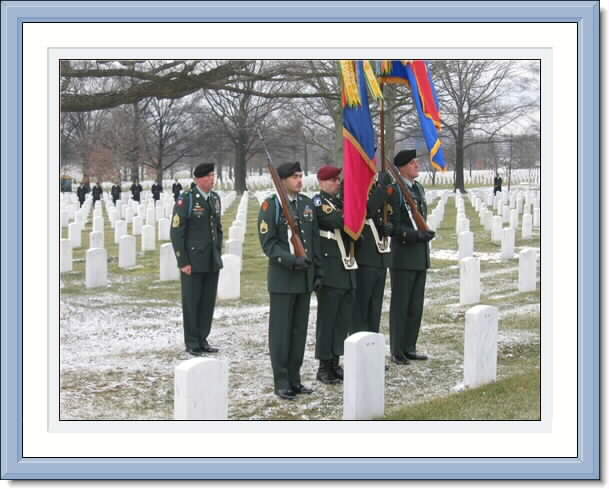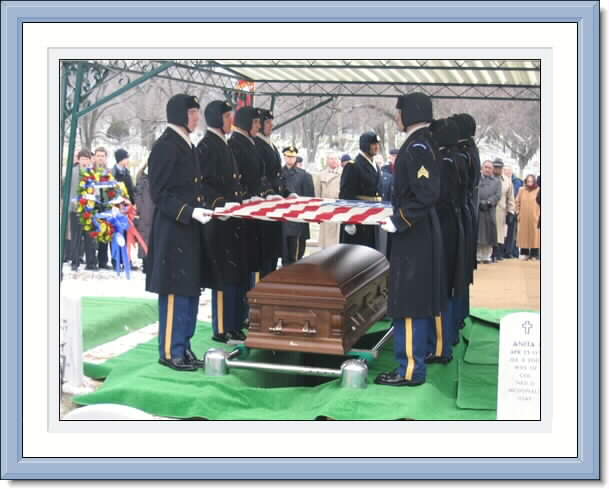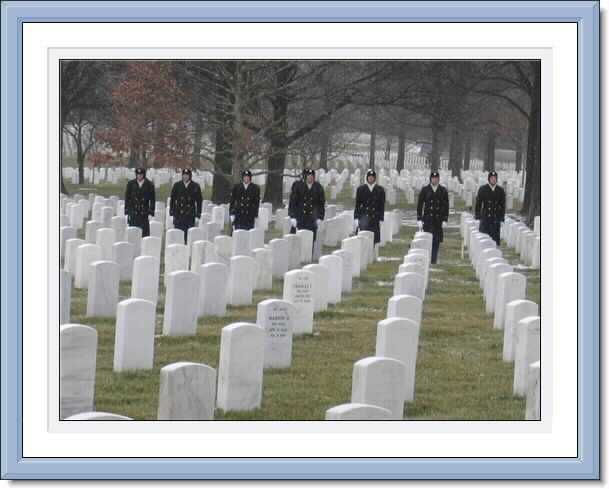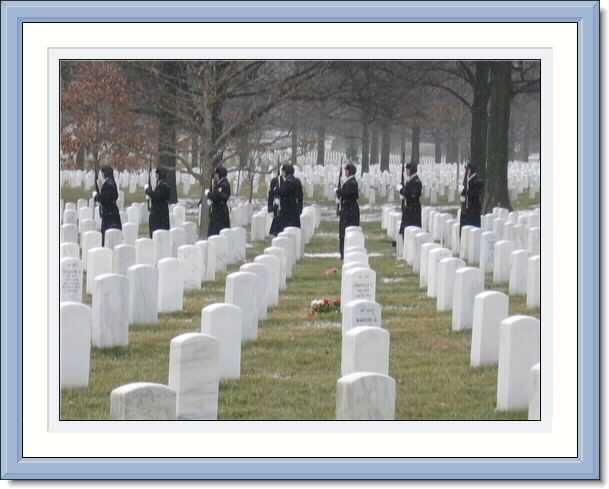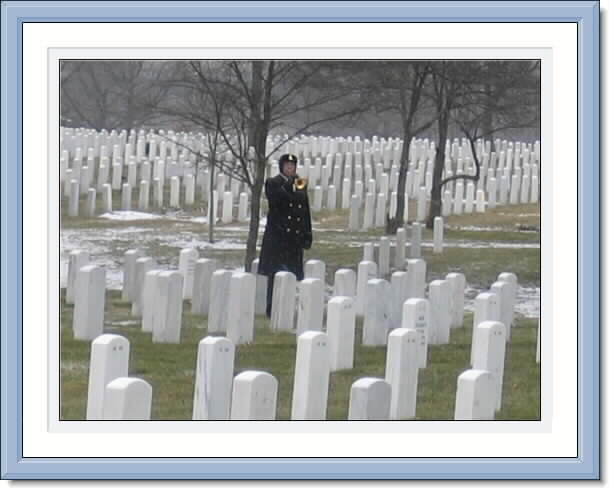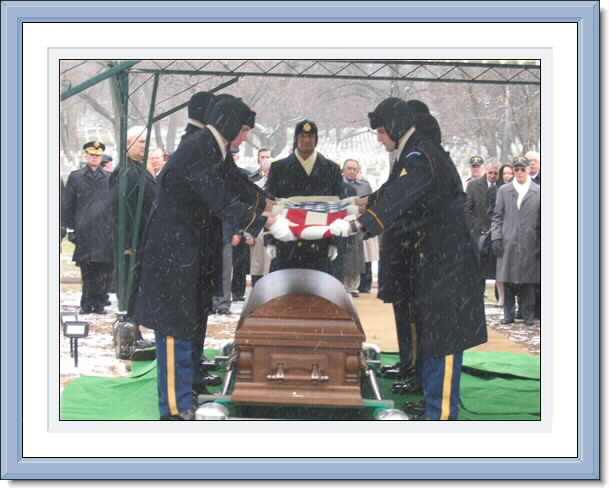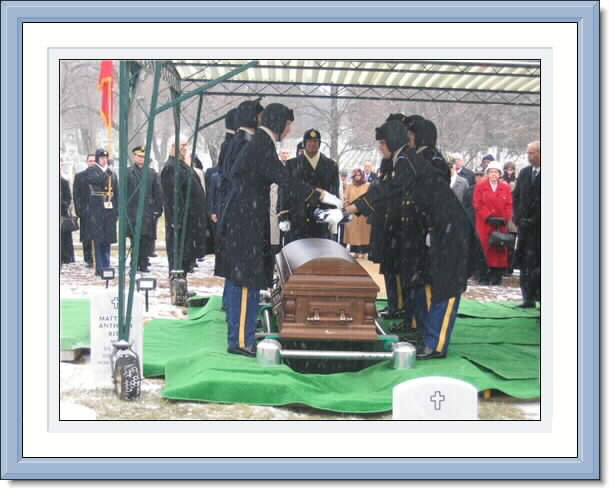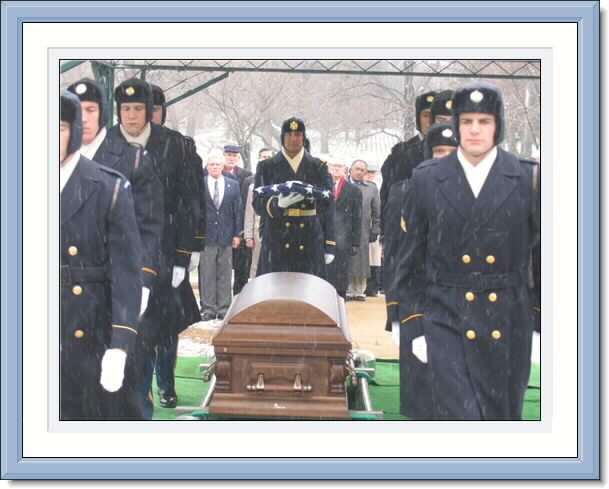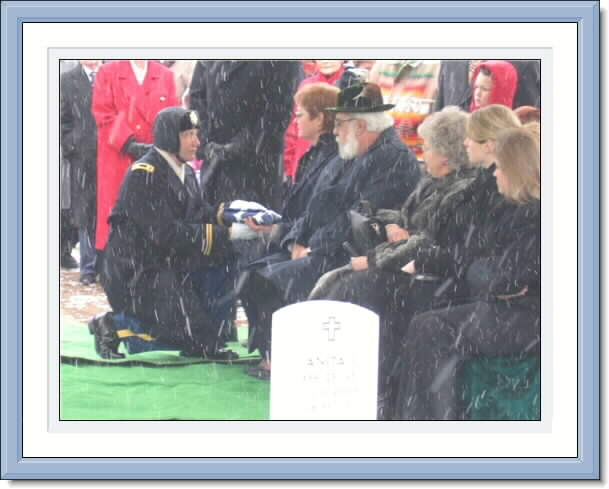Major General Ellis W. Williamson, new 25th Infantry Division Commander, assumed command during ceremonies held at Cu Chi Saturday morning, August 3, 1968.
He replaces Major General F. K. Mearns, who moves to Saigon to become Deputy Commander, II Field Force and Commanding General, Capital Military Assistance Command.
General Williamson was born in Raeford, North Carolina on June 2, 1918. Through high school and college, he was a member of the 120th Infantry Regiment, North Carolina National Guard.
Upon graduation from Atlantic Christian College with a Bachelor of Arts degree in 1940, he entered the Federal Service with his unit.
General Williamson remained with the 120th Infantry Regiment throughout World War II serving in rank from Private to Colonel. Following commissioning as a Second Lieutenant of Infantry in March, 1941, he served as a commander at platoon, company, battalion and regimental level and as a battalion and regimental staff officer. He was regimental Commander at the time of the unit’s return to state control in January, 1946.
The same year, he was integrated into the Regular Army. For three years he was an instructor of tactics at the Infantry School. He graduated from the Command and General Staff College in 1950 and was assigned to Headquarter X Corps in Korea. He participated in the amphibious landing at Inchon as Assistant Operations Officer, X Corps, later becoming Operations Officer.
General Williamson was assigned in 1952, to the Office of the Army Chief of Staff, next attended the Armed Forces Staff College, and then returned to Washington for duty in the Office of the Secretary of Defense.
He assumed command of the 13th Infantry Regiment at Fort Carson, Colorado, in 1956 and took this unit to Germany on Operation Gyroscope. After 27 months as Regimental Commander, he became Chief of the Training Division, Headquarters, 7th U.S. Army. He returned home to qualify as a parachutist and attend the National War College.
Following three years in the Office of the Deputy Chief of Staff for Personnel at Department of the Army, General Williamson assumed command of the 173d Airborne Brigade (Separate) upon its activation in Okinawa in July 1963. He organized and trained this unit for its mission as Pacific Theatre Reserve Force during the next two years.
After extensive training on the Pacific islands of Okinawa, Taiwan, Irimote, and the Philippines as well as in Korea and Thailand, General Williamson’s brigade, in May, 1965, became the first U.S. Army ground combat unit to enter the conflict in Vietnam.
Under his command, the 173d Airborne Brigade (Separate) participated in actions designed to protect friendly installations and to destroy enemy forces in the Bien Hoa-Vung Tau-Ben Cat areas and into the mountain plateau areas of Pleiku and Kontum.
In addition to the 173d Airborne Brigade (Separate), General Williamson’s command in Vietnam included all Australian and New Zealand combat elements, plus some Vietnamese units.
He served in five campaigns in Europe during World War II and seven during the Korean conflict.
General Williamson assumed command of the U.S. Army Training Center, Fort Polk, Louisiana, November 1, 1966, and comes to the 25th Infantry Division from that post.
Major General Williamson has received the:
Distinguished Service Cross
Distinguished Service Medal
Silver Star with five Clusters
Legion of Merit with Cluster
Bronze Star Medal with three Oak Leaf Clusters
Air Medal with nine Clusters
Army Commendation Medal
Purple Heart with two Oak Leaf Clusters
American D e f e n s e Service Medal
American Campaign Medal
European, African, Middle Eastern Campaign Medal
World War II Victory Medal
Army Occupation Medal (Germany)
National Defense Service Medal with Oak Leaf Cluster
Korean Service Medal
United Nations Service Medal
Vietnamese Service Medal
Distinguished Unit Emblem
Department of Defense Identification Badge
Army General Staff Identification Badge
Combat Infantryman’s Badge
Master Parachutist’s Badge
British Distinguished Service Order
French Croix de Guerre with Silver Star
National Medal of Vietnam Vietnamese Cross of Gallantry, with Palm
Vietnamese Army Distinguished Service Medal, First Class
Belgian Fourragere
Republic of Korea Presidential Unit Citation Badge
February 8, 2007:
Major General Ellis W. Williamson, who led the first Army combat troops into South Vietnam, died on January 28, 2007, in Arlington, Virginia. He was 88. Jean O’Neil, a friend of the family, announced the death.
General Williamson participated in the D-Day landings in Normandy in World War II and the Inchon landings in the Korean War. He held high-level posts supervising troop training and, from 1971 to 1973, was chief of the United States military mission to Iran.
In 1963, General Williamson reactivated the 173rd Airborne Brigade, which had begun as an infantry brigade in World War I and was absorbed into other units in World War II. For two years, his 3,500 troops trained intensively in Okinawa.
They began arriving in Vietnam on May 5, 1965. Their first mission was to secure, patrol and neutralize any threat to Bien Hoa Air Base. That day, General Williamson said in an interview with The New York Times, “I am sure my men will want, as I do, to get out for action.”
Then 47, General Williamson developed tactics for a war with no defined front. Fighting with South Vietnamese troops, he had his men penetrate the countryside surrounding the base and then worked methodically to expand the perimeter with day and night patrols.
The members of the 173rd were among the first soldiers to use M-16s, the lightweight rifle that became the standard for American forces. Hardly a night went by when they were not attacked.
They were also the first to go into what the military called Zone D, a flat, eerie jungle filled with dragonflies and Vietcong sniper bullets, to destroy enemy base camps. This successful operation in June 1965 was American troops’ first big attack against the Vietcong.
In August 1965, General Williamson commanded the 173rd and other American units when they and South Vietnamese troops broke the Communist siege of a Special Forces camp at Duc Co. By September, he told The Times, “The enemy is running from us like a scared rat.”
The next year, General Williamson led United States troops into the Mekong Delta for the first time. In March 1966, he briefed President Lyndon B. Johnson at Johnson’s ranch in Texas. He told the president that morale was high and that the enemy was groggy; he also advised sending more troops.
Ellis Warner Williamson was born in the summer of 1918 in Raeford, North Carolina. He served in the North Carolina National Guard during high school and college. In 1940, he graduated from Atlantic Christian College, now Barton College, and was commissioned a Second Lieutenant.
In addition to taking advanced courses at military schools and colleges, he received an M.B.A. from Harvard in 1962 and a master’s in international affairs from George Washington University in 1963.
He became a paratrooper in 1959, and was promoted to Brigadier General in 1963. General Williamson returned from Vietnam in 1966 to be Assistant Commander at the Infantry School at Fort Benning, Georgia. After being promoted to major general, he commanded the Army Training Center at Fort Polk, Louisiana.
As chief of the military mission to Iran, General Williamson met regularly with Shah Mohammed Reza Pahlavi and oversaw a quiet but steady influx of American military personnel into Iran.
On September 27, 1942, General Williamson married Margaret McNeill, who survives, along with a daughter, Nan V. Williamson of Clyde, North Carolina; a son, Dan, of Pineville, Missouri; and a grandson.
Ellis W. “Butch” Williamson, 88, a retired Army major general who served in World War II, Korea and Vietnam, died January 28, 2007, of pneumonia at Goodwin House in Arlington County. He was a longtime Arlington resident.
General Williamson was born in Raeford, North Carolina, and served in the North Carolina National Guard during high school and college. He graduated from Atlantic Christian College (now Barton College) in 1940 and was commissioned a Second Lieutenant.
He participated in the D-Day landings with the 120th Infantry Regiment and served in the European theater, where he commanded at the platoon, company, battalion and regimental levels.
In 1950, he helped plan and participated in the Inchon landing in Korea. Following instructional and staff assignments, he assumed command of the 13th Infantry Regiment at Fort Carson, Colorado, and took the regiment to Germany. In 1959, he became an Army paratrooper.
During his 40-year military career, he received a master’s degree in business from Harvard University (1962) and a master’s degree in international affairs from George Washington University (1963).
Promoted to Brigadier General in 1963, he organized the 173rd Airborne Brigade on Okinawa and took the brigade into Vietnam in 1965. His unit was the first U.S. Army ground combat unit to enter the war.
In 1966, he became assistant commander at the Infantry School at Fort Benning, Georgia. Promoted to Major General, he assumed command of the U.S. Army Training Center at Fort Polk, Louisiana, and then returned to Vietnam, where he commanded the 25th Infantry Division, known as Tropic Lightning.
In 1971, he was designated chief of the U.S. military mission in Iran and personal adviser to the shah of Iran. He retired in 1973.
In retirement, he worked as a military affairs consultant and was involved in military and civilian nonprofit community activities. He served on the boards of the Army’s Military District of Washington Retiree Council and the Army Distaff Foundation and was active with the Sigholtz-Capital Chapter of the 173rd Airborne Brigade Association. He was a member of the Greater Washington Metropolitan Organ Society.
General Williamson’s decorations include the Distinguished Service Cross, the Distinguished Service Medal with two oak leaf clusters, the Silver Star with five oak leaf clusters, the Legion of Merit, the Bronze Star Medal and the Purple Heart.
Survivors include his wife of 64 years, Margaret Williamson of Arlington; two children, Nan V. Williamson of Clyde, North Carolina, and Dan E. Williamson of Pineville, Missouri; and one grandson.
Ellis W. Williamson, Major General, U.S. Army (Ret)
June 4, 1918-Jan. 28, 2007
Major General Ellis W. Williamson died Jan. 28, 2007, at the age of 88.
His 40-year Army career included service in World War II, Korea and Vietnam.
He is survived by Margaret, his wife of 64 years; a son, Dan E. Williamson Sr. of Pineville, Missouri; a daughter, Nan V. Williamson of Clyde, North Carolina; two grandchildren, Dan E. Williamson Jr. of Stephenville, Texas, and Christina L. Franklin of Ft. Worth, Texas; and four great-grandchildren, Holly, Wesley, Christopher and Danielle Franklin of Ft. Worth, Texas.
Born in Raeford, North Carolina, he grew up and went to high school in Raleigh, North Carolina. He served in the North Carolina National Guard during high school and college. He graduated from Atlantic Christian (now Barton) College, Wilson, North Carolina, in 1940 and was commissioned a Second Lieutenant.
Highlights of General Williamson’s military career include participation in the D Day landings with the 120th Infantry Regiment, and service in the European theater where he commanded at the platoon, company, battalion and regimental levels, earning temporary promotions through the rank of Lieutenant Colonel. In 1950 he was on the planning staff for and participated in the Inchon Landings in Korea, and subsequently served on the X Corps staff. Following instructional and staff assignments in the United States, he assumed command of the 13th Infantry Regiment at Fort Carson, Colorado, and took the Regiment to Germany. In 1959 he became an army paratrooper.
Promoted to Brigadier General in 1963, he organized the 173rd Airborne Brigade (Separate) on Okinawa and took the Brigade into Vietnam in May of 1965, becoming the first United States Army ground combat unit to enter the conflict. In 1966 he became Assistant Commandant at The Infantry School, Fort Benning, Georgia. Subsequently he was promoted to Major General and assumed command of the U. S. Army Training Center at Fort Polk, Louisiana. In 1968 he returned to Vietnam, commanding the 25th “Tropic Lightning” Infantry Division.
He was designated Chief of the U. S. Military Mission in Iran and Personal Advisor to the Shah of Iran in 1971 and subsequently retired in 1973. Following retirement, he continued his life of service to the community, participating in a variety of military and civilian non-profit community activities.
His military education included basic and advanced courses at the Infantry School (1942-43), the Command and General Staff College (1950), the Armed Forces Staff College (1953), and the National War College (1960). He was granted a Master’s degree from the Graduate School of Business at Harvard University in 1962 and a Master’s degree in International Affairs from George Washington University in 1963.
Major General Williamson’s numerous decorations include the Distinguished Service Cross, the Distinguished Service Medal (2 OLC), the Silver Star (5 OLC), the Legion of Merit (OLC), the Bronze Star Medal (3 OLC), the Distinguished Flying Cross, the Air Medal (28 OLC), the Purple Heart (4 OLC), the Combat Infantryman Badge, the Master Parachutist Badge and Army Aviator Wings.
Services will be held at Arlington National Cemetery on March 7, 2007.
The family has requested that memorial contributions be sent to the 173rd Airborne Brigade Memorial Foundation, 1160 Lake Royale, Louisburg, North Carolina 27549 or to Barton College, Office of Institutional Advancement, designated to the Ellis W. Williamson Family Endowed Scholarship, PO Box 5000, Wilson, North Carolina 27893.
Margaret McNeill Williamson died on February 16, 2007 at age 88 of problems arising from the effects of a fall. Margaret was married for 64 years to Ellis W. Williamson, Major General, U.S. Army, who retired in 1973 after 40 years of service. General Williamson predeceased his wife of 64 years by less than three weeks, on January 28 of this year.
Mrs. Williamson is survived by her daughter Nan V. Williamson, Clyde, North Carolina; son Dan E. Williamson, Pineville, Missouri; grandson Dan E. Williamson, Jr., Stephenville, Texas; step-granddaughter Christina Franklin, Saginaw, Texas; sisters Alice McNeill, Atlanta, Georgia, and Anne McNeill, Charlotte, North Carolina; nieces Shelley Hale Lee, Altadena, California; Meredith Hale, New York, New York; RayAnn McNeill Bradford, Sacramento, California; Charla McNeill, Emmett, Idaho; and nephew John McNeill, Woodland, California.
Margaret was born in Morganton, North Carolina, in 1918, grew up in Charlotte and Greensboro, North Carolina, and attended Averett College in Danville, Virginia. She married “Butch” Williamson, then a Second Lieutenant in the U.S. Army, in 1942 as the World War II mobilization began. From that time on she was devoted to her husband and began her career as a military wife. Like many military wives, she managed her household and cared for her children through numerous separations and many transfers. As the wife of the commander of infantry and airborne troops, she assisted many wives and families on posts in the U.S., including Fort Carson, Colorado, Fort Benning, Georgia and Fort Polk, Louisiana, as well as on assignment in Germany, Okinawa and Iran. They maintained a residence in Arlington, Virginia, which they occupied during assignments at the Pentagon and after General Williamson’s retirement.
Margaret Williamson’s most notable contribution occurred during the Vietnam War. Margaret is known as the first “First Lady” of the 173rd Airborne Brigade (Separate). She accompanied her husband to Okinawa in 1963, when the Brigade was formed. When the Brigade deployed to Vietnam in May 1965, Margaret assumed a critical role, leading and caring for 700 family members who had been stationed with the Brigade on the island of Okinawa. She acted as counselor, mentor, and guide to many a young woman who had never had never faced having to relocate her family while worrying about her husband in a war zone.
She quickly organized the women into what was called “The Dependants Assistance Office.” Under her guidance, and with the help of the few officers left on island, the DAO undertook to “take care of their own.” They helped to guide those with financial and emotional problems, delivered death notifications, helped when children were born, or when family members were sick or injured. Margaret did all of this while her own husband was commanding the Brigade in Vietnam.
Ninety days after deployment, the Dependants Assistance Office, with Margaret’s encouragement, joined Air Force and Army personnel to prepare families to be evacuated off island, getting papers signed, forms completed, and families notified. Soon after the evacuation, the Army created what is now called Army Community Service. Many believe that ACS would not have been established as soon as it was without the example of Margaret Williamson’ active leadership in Okinawa.
As the wife of a commander on overseas assignments, Margaret had many responsibilities. In Iran she entertained many, including heads of state, ambassadors from the U.S. and foreign countries, US Congressional Delegations, and senior military officers, all while training and supervising the army staff assisting her. She visited women’s groups, schools and hospitals while traveling throughout the country. In performing these duties, she was a role model for young officers’ wives and mentored many to learn the requirements that such positions impose.
Even with such distinguished service, Margaret Williamson viewed her achievements modestly. She was a consummate and gracious hostess, an avid bridge player, and an art lover, attending art museums at every opportunity. She was a thoughtful friend, keeping in touch with many through calls, cards and notes and never seemed to forget a face or name.
The family requests that memorial contributions be sent to the Washington National Cathedral, Massachusetts & Wisconsin Avenues NW, Washington, DC 20016.
The funeral service for General and Mrs. Williamson will be held March 7, 2007. at the Old Post Chapel, Fort Myer, Arlington, Virginia, with burial at Arlington National Cemetery.
MARGARET WILLIAMSON
On Febraury 16, 2007, MARGARET WILLIAMSON of Falls Church, Virginia. Beloved wife of the late Ellis W. Williamson; mother of Dan E. Williamson and Nan V. Williamson; sister of Alice McNeill and Anne McNeill. She is also survived by two grandchildren and five great-grandchildren. Services will be held at Fort Myer Chapel on Wednesday, March 7 at 11 a.m. with interment to follow at Arlington National Cemetery. In lieu of flowers, memorial contributions may be made to the Washington National Cathedral, 3101 Wisconsin Ave., N.W., Washington, DC 20016.
Eulogist – Lieutenant Colonel (Retired) Roy S. Lombardo, Jr., USA
We gather today to remember a man and a woman, who were important to us all. He was a Father, a Leader without peer, a friend, a mentor, a Southern gentleman, and most of all an Infantry soldier. She was a Mother, Army wife extraordinare, a steel magnolia, and the wind beneath his wings Those present know them, both, well and the military life of MG Ellis Warner Williamson, but I would like to touch on some of those events that I think need embellishment, particularly in the early years.
I am Roy Lombardo and have known General Williamson since 1963, when he came to Okinawa to form the 173d Airborne Brigade. I commanded a Rifle Company under him on Okinawa and in Vietnam, then followed him to the Infantry School as a student and later as an instructor. There are many here who have known him better than I, but there are none here who have respected him more or cared for him more deeply. In my view, he was one of the greatest of the GREATEST GENERATION.
But I will take a liberty here of which I think he would approve. Many times in the waning years of our 43 year relationship, he encouraged me and others to address him as Butch. Of course, I and Colonel Tyler and others were never comfortable with that form of familiarity. But now I feel it is appropriate to talk about the man, known as Butch. I am old enough to understand why he was known as Butch. I can also understand why a boy, whose name was Ellis, might prefer to be known at Butch. But I strongly suspect from what I know of his tough, uncompromising style as an adult, that he earned that name, fairly, by his toughness as a youth and later as a soldier.
Butch started his 40 year military journey as a private soldier in the 120th Infantry Regiment of the 30th Infantry Division, the Old Hickory Division, while in High School and remained in that Regiment for 11 years. Initially he was a trombone player in the band and stated that he dreamed of playing with Tommy Dorsey, not knowing that WW II would intervene and alter those plans.
He remained an enlisted man, while he finished high school and college. After college graduation he attended Infantry Officer Basic Training and was commissioned in March 1941, when he was quickly selected to command 2 different Rifle Companies.
When the 30th Infantry Division landed at Omaha Beach, he was a Captain and the Operations Officer of the 1-120 Infantry Regiment. Shortly, when his Battalion Commander became ill, the Regimental Commander appointed him, the youngest Captain in the battalion, as the Battalion Commander of the 1-120 Infantry. He remained the Battalion Commander for the period preceding and following the Breakout at St Lo.
In late July 1944, the Breakout from the hedgerows was facilitated by Army Air Corps massive carpet bombing, some of which fell on this new Battalion Commander and his soldiers, burying many. He was wounded and blown from his trench by the blast and was trying to recover and dig others out, when the Asst Division Commander walked up and asked, “Butch, how many men can you get together right now?”
“Sir, about fifty but they have to dig out and find their weapons.”
General Harrison said, “Let’s you and I go. Tell the others to catch up as soon as they can.” There and in other scenes just like it, the indomitable will of mission-focused Officers wrested success from the jaws of what could have been a major tactical failure. He would later repeat this leadership by example action many times. Chaplain Hutchens has already spoken of a similar action in 1965.
He was shortly replaced by a Lieutenant Colonel, as Battalion Commander, and moved up to be the regimental S-3/Operations Officer as a 26 year old Captain. Just a few days later, the Regiment fought at Mortain to blunt the attack of the 2d German Panzer Division, earning a Presidential Unit Citation.
The 30th Division would fight on and Butch would quickly be promoted to Major and again assume command of the 1-120 Infantry, which he would retain until he took command of the regiment to bring it home to North Carolina after the war. I have already given an example of Butch’s focus on Mission Accomplishment, but want to briefly touch on his corresponding care for the troops in his battalion. During the Battle of the Bulge, many of the casualties were cold weather injuries and displaced soldiers as quickly as wounding. Recognizing the need to protect the feet of his soldiers, he designed a type of footgear that would work. He hired a tailor in Belgium to use shelter halves and wool blankets to make a mukluk type of footgear, which precluded any of his soldiers from cold weather foot injuries.
So from Private to Regimental Commander in 11 years in the same Regiment. Definitely one of the greatest of the Greatest Generation.
During the Korea War, he was instrumental in planning the amphibious assault at Inchon later becoming the G-3/operations officer of X Corps. He was still the G-3 for the amphibious landing at Wonsan on the east coast in October before the X Corps drove to the Yalu, the northern-most forces in 8th Army as well as the withdrawal by sea in December of the 1st Marine and the 7th Infantry Divisions. His amphibious acumen was in such high regard that LTG Schwartzkopf, upon assuming command of I Corps, invited Major General Williamson to lecture the I Corps staff on the intricacies of amphibious operations in Korea when there is often a 20 foot tidal fall, that makes exact timing essential.
Not much is known of his command of the 13 th Regiment but he oversaw the conversion from the regiment to a battlegroup and its gyroscoped deployment to Germany. In my service, I met his former Adjutant, who remarked that not one piece of correspondence left his HQ without his personal review. Now that is attention to detail!!
This focus on detail was displayed on Okinawa during the first Readiness Reporting, when Major General D’Orsa, the Deputy Ryukyuan Commander, challenged the accuracy of the Brigade Readiness Report. Brigadier Genreal Williamson stood and stated, “The report is accurate because I, personally, saw to its accuracy.” Major General D’Orsa withdrew his challenge and accepted the report.
Most all here know of the Brigade’s deployment and outstanding service in Vietnam, so I leave that to your memories. I will suggest that he translated the Brigade’s airborne experience into an immediate embrace and expert application of the airmobility concept, OVERNIGHT! He pioneered what he called the Jitterbug to insert rifle platoons by helicopter into an Area of Operations to establish contact with the elusive enemy, piling on additional forces and firepower, if contact was made or withdrawing to repeat the process in another area. He fully grasped the maneuver enhancement of airmobility and learned to fly, one of the first general Officers to become a qualified aviator.
In early 1966, as a result of his success in Vietnam, he became the Assistant Commandant of the Infantry School, where he quickly turned the Infantry School’s focus from a mechanized war in Europe to training for the Jungle War in Vietnam. He established a television program series for returning officers to recount their Lessons Learned for the review and benefit of those that would follow. Veterans of the 173d were brought in as instructors to overcome the lethargy that existed and, believe me, it was quickly overcome under his oversight.
Next to Fort Polk, where he quickly converted a sleepy, Louisiana training center to a Vietnam Warrior Production Factory. The training at his Vietnam Village was a model that saved the lives of many young soldiers, who quickly learned and learned well one of his battle axioms, “Use bullets, not bodies.”
Then his rapid return in 1968 to command the 25th Tropic Lightning Division, one of the very few officers to command a brigade and return to command a division. On many occasions, he landed on the battlefield to add his presence and personal example to favorably tilt the battle toward victory.
After service in the Pentagon, he was selected as Chief of the Military Mission to Iran, a delicate task requiring sensitive diplomatic relations with the Shah, while overseeing the supply of military equipment and training in its use and maintenance. Sadly this courageous dynamo almost destroyed his health in service to his country and was medically evacuated and then medically retired in 1973.
Success in life is never possible without a loving and resourceful wife and partner. Throughout Magaret was at his side, supporting, encouraging, understanding, raising their family, and being the perfect balance to his aggressive style. She knew my children by name and through them my grandchildren. At a picnic at the FBI academy, she held my grand daughter and told her that she used to hold her Mommy and Uncle Lance on Okinawa. She recalled at a recent luncheon that we were from New Orleans and wanted to know how our family was affected by Hurricane Katrina. We were only one of thousands of families that had served with the Williamson’s but she remembered all of those that were their family. Together they were two of the Greatest of the Greatest Generation
Whenever I come here to Arlington Cemetery, I am reminded of the Bill Mauldin cartoon, which he drew for President’s Eisenhower’s burial. There were ghostlike figures among the tombstones, with helmets and sergeant chevrons and the caption read,” Pass the word, it’s Ike.” So today as we travel to the gravesite, listen carefully and if you do, from soldiers and Army wives of yesteryear you might hear, “Pass the word, it’s Butch and Margaret.”
Photos Courtesy of
Lieutenant Colonel (Retired) Roy S. Lombardo, Jr., USA
Wendy, Roy and Carol Lombardo At General Williamson’s Funeral Services
Arlington National Cemetery
Michael Robert Patterson was born in Arlington and is the son of a former officer of the US Army. So it was no wonder that sooner or later his interests drew him to American history and especially to American military history. Many of his articles can be found on renowned portals like the New York Times, Washingtonpost or Wikipedia.
Reviewed by: Michael Howard

